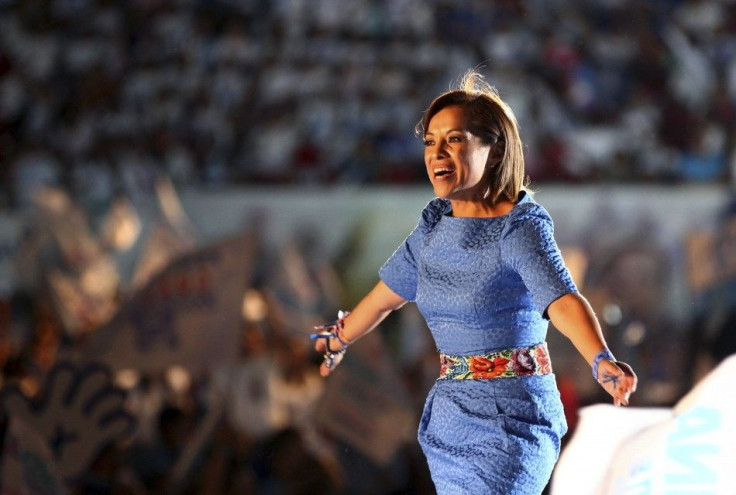Mexico Election: Who Are Enrique Peña Nieto And The Other Two Top Candidates?

CUERNAVACA, Mexico -- Mexican voters will head to the polls Sunday to elect the country's next president and vote in an entirely new Congress (500-member lower house and 128-member Senate). Additionally, six governorships (the states of Morelos, Jalisco, Chiapas, Tabasco, the Federal District, and Guanajuato) are being contested, as well as the mayoralties of key cities.
If the polls bear out, poised to win the presidency handily is Enrique Peña Nieto, the popular former governor of the vote-rich State of Mexico, whose well-oiled campaign has never slipped from frontrunner status, consistently maintaining strong leads over its two main opponents:Andrés Manuel López Obrador of the center-left Party of the Democratic Revolution (PRD), and Josefina Vázquez Mota of the center-right National Action Party (PAN).
In this week's final media polls, Peña Nieto commands leads of between 10 and 17 percentage points over the second-place López Obrador. A comfortable margin for Mexico's next president is important, since it would allay fears of post-election rancor and civil strife and provide a clear mandate - something that outgoing President Felipe Calderón lacked in his first days in office in 2006 after winning by less than seven-tenths of one percentage point over López Obrador. Because many Mexicans felt the close margin was the product of a conspiracy to deny the left-leaning López Obrador a victory, the election was widely disputed and cast a pall over Calderón's first days in office.
Below are profiles of the top three contenders in Mexico's 2012 presidential election:
The Frontrunner: Enrique Peña Nieto
The candidate of the Institutional Revolutionary Party and former governor of Mexico's most populous state, the State of Mexico, Enrique Peña Nieto is far and away the frontrunner heading into tomorrow's vote. His juggernaut campaign has capitalized on voter disenchantment after two terms (twelve years) of PAN presidencies; projected an air of cool discipline and competence in contrast to the bickering and division of the rival parties; and received favorable -- some say prejudiced -- coverage from the country's major broadcasters. These factors, along with the candidate's good looks and charisma, if not strong policy and intellectual credentials, have made him the odds-on favorite to replace Calderón come December, when the president's term ends.
Analysts note that there are two main reasons behind Peña Nieto's success. First are the unique political and economic circumstances of this year's race. High levels of narcoviolence, disappointing economic growth, and incumbency fatigue have worked strongly in Peña Nieto's favor. At the same time, the PRI's legacy of governance - it controlled Mexican politics for most of the 20th century - and momentum from the party's near-sweep of the 2009 midterms have convinced voters that Peña Nieto is the best of the current field. Additionally, his party's organizational capacity at the local and state levels is particularly formidable: the PRI controls the governorships of close to three-quarters of the Mexican states, and in this cycle has made surprising plays in PAN bastions, such as the conservative western state of Jalisco.
A Diferente Candidate: Josefina Vazquez Mota
The first female presidential candidate in Mexican history, the PAN's Josefina Vazquez Mota would probably be a formidable contender in any other election cycle. But in this year's race, the otherwise strong candidate has been blindsided by Peña Nieto's juggernaut campaign and has suffered from her own party's relative organizational weakness at the state and local levels. Additionally, campaign incompetence and incumbency fatigue with fellow party member Calderón has hurt her. An example of internal division within her campaign: the haphazard mid-race decision to switch her official slogan from Josefina Diferente to Josefina La Jefa. The change led to brand confusion, provided the media with an easy target, and did not help Vazquez Mota's poll numbers, which have hovered in the mid-20 percent range compared with a consistent 40 percent and higher for Peña Nieto. More recently, the Vazquez Mota campaign suffered another intrapartisan wound, when former president Vicente Fox asked her supporters to shift allegiance to Peña Nieto, lest Lopez Obrador, who consistently polls in second place, make a stronger-than-expected showing.
The Populist: Andres Manuel López Obrador
This will probably be the last serious presidential challenge by populist center-left politician Andres Manuel López Obrador, a former governor of the Federal District who nearly won the 2006 race. Lopez Obrador's poll numbers have improved modestly throughout the race and show him a consistent second with around 30 percent. Yet it appears highly unlikely that he can hope for anything better than a distant second-place finish, and it is highly unlikely that he will be able to marshal loyalists to challenge vote results or lead anti-government street protests as occurred in late 2006. Then, Mexico City was held hostage by López Obrador supporters, who waged a months-long sit-in in to force a comprehensive review of all ballots. However, this time around, there appears to be little appetite for indulging such protests by either outgoing Mexico City Governor Marcelo Ebrard or his likely successor, Miguel Mancera, even if both of them belong to the PRD like López Obrador. This is partly because such protests would be incongruent with what is expected to be a stronger-than-expected showing by the party in the day's congressional and gubernatorial votes, including projected wins outside of its Mexico City bastion.
Robert Donnelly is a political analyst currently based in Cuernavaca, Mexico. He formerly worked at The Wilson Center Mexico Institute, a major think tank on U.S.-Mexico issues, and has written extensively on immigration and U.S.-Mexico border issues.
© Copyright IBTimes 2024. All rights reserved.











